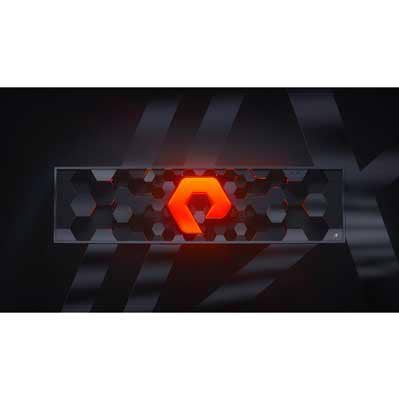Pure Storage Pushes All-flash Performance With NVMe-oF RoCE, Intros Flash Storage For Cloud Backups

All-flash storage technology developer Pure Storage on Tuesday said it is significantly increasing performance of its FlashArray//X line by replacing its traditional iSCSI connectivity with its new DirectFlash Fabric technology.
With DirectFlash Fabric, Pure Storage becomes the first to implement NVMe-oF RoCE, or NVMe over Fabric with RDMM over converged Ethernet, said Chadd Kenney, vice president of products and solutions for the Mountain View, Calif.-based vendor.
Pure Storage also aims to add all-flash storage performance to customers' data protection environments with the introduction of ObjectEngine, which it termed the industry’s first data protection platform purpose-built for flash and cloud.
[Related: Pure Storage CEO Giancarlo On StorReduce Acquisition And Measuring Flash Storage Success]
FlashArray//X, which was introduced about two years ago, was one of the first mainstream enterprise flash storage arrays to feature high-performance, high-density NVMe technology.
FlashArray//X featured Pure Storage's DirectFlash software to squeeze as much performance as possible out of the array, especially in direct-attach storage (DAS) environments. However, the performance in shared storage and cloud environments was constrained by the iSCSI connectivity, Kenney told CRN.
"DirectFlash Fabric takes out iSCSI, and replaces it with RDMA over converged Ethernet," he said. "That provides up to a 50-percent reduction in latency over iSCSI, and a 20-percent performance gain over Fibre Channel."
The performance improvement stems from RDMA, or remote direct memory access, which offloads many of the storage operations from the arrays' processors, he said.
FlashArray//X supports end-to-end NVMe with 25-Gbit and 50-Gbit Ethernet. Network interface cards interoperable with NVMe-oF are available or planned from Broadcom, Cisco, Marvell, and Mellanox, Kenney said.
Pure Storage released the firmware upgrade to its Purity 5.2 storage operating system in January, Kenney said. Customers can upgrade their arrays to NVMe-oF RoCE by replacing their DirectFlash module with the updated software, he said.
Pure Storage's ability to increase the performance of its FlashArray//X bodes well for clients, said Mark Galyardt, executive vice president of XIOSS, an Atlanta-based solution provider and Pure Storage channel partner.
"They have a great track record," Galyardt told CRN. "Customers want increased performance. Media and entertainment, biotech, and more all need to process files as fast as possible."
Pure Storage has been leading the charge when it comes to all-flash storage, said Cindy Kennedy, president of the western region of Converge Technology Partners, a Toronto-based solution provider and Pure Storage channel partner.
"Pure Storage has changed the industry in the kinds of performance and applications that can be offered to customers," Kennedy told CRN. "But other vendors are catching up. Pure Storage needs to do even better."
Pure Storage's new ObjectEngine all-flash data protection platform is aimed at bringing flash storage to the data protection market which until now has been dominated by disk-to-disk-to-tape architectures, said Brian Schwarz, vice president of product management.
"We're now taking data protection to flash-to-flash-to-cloud," Schwarz told CRN.
ObjectEngine is based heavily on technology Pure Storage received with its 2018 acquisition of StorReduce, Schwarz said.
The use of flash storage to replace spinning disk for data protection is important in terms of reducing restore times, which currently can take one or more days, Schwarz said. "Restores take much more longer than people realize," he said. "But downtime today are unacceptable."
ObjectEngine creates Amazon Web Services S3-compatible data sets that can be copied to an on-premises ObjectEngine for fast local restores, and also on an S3-compatible cloud for longer-term, lower-cost protection, Schwarz said.
The data can be restored from the cloud to on-premises storage or to another cloud either for restores or as copies of production data for use in security, compliance, or analytics, he said.
ObjectEngine will work with most customers' existing data protection software, including Veritas, Commvault, and Veeam, all of which write data to S3, Schwarz said.
It is available in two versions.
The first is ObjectEngine//A, an appliance version that delivers 25 TBs per hour backup performance and 15 TBs per hour restore performance. The included StorReduce deduplication technology can reduce storage and bandwidth costs by up to 97 percent. It is slated to be available in March, with the CloudDirect cloud integration slated to be available in May.
The second, the software-defined ObjectEngine//Cloud, is a cloud-native, AWS S3-compatible cloud object storage platform which offers an internally replicated global namespace with a single pane of glass for data across hybrid cloud. It scales to over 100 Tb per hour backup performance, and protects over 100 petabytes of data in the cloud. It is slated to be available in the second half of 2019.
There are definitely a lot of enterprise customers looking for ways to better handle high-performance workloads, including how to replicate them in the cloud, Kennedy said. However, she said, it will take time before the market at large is ready for flash-to-flash-to-cloud data protection.
"All things considered, if the price is equal to other data protection platforms, it's a no-brainer," she said. "But price is not equal. It will be a long journey to get customers to use flash for backups. but there will be use cases. If customers want to do analytics against their data, this may be the economical way. Customers may not want to use their production data for such cases."
Even so, for customers who need accelerated restores of data from the cloud, ObjectEngine could be the next revolution and Pure Storage the next disrupter, Kennedy said.
"In the next three to five years, we could see no more spinning disk in the data center," she said. "This could be the start of that evolution."
S3-compatibility is table stakes for data protection on-premises or in the cloud, and ObjectEngine is providing a path for flash-to-flash data protection, Galyardt said.
"It's a good move for Pure Storage," he said. "Everybody likes flexibility and no one likes vendor lock-in. This opens new use cases for clients. We're having more and more conversations with clients about tiering data to less expensive media like the cloud."